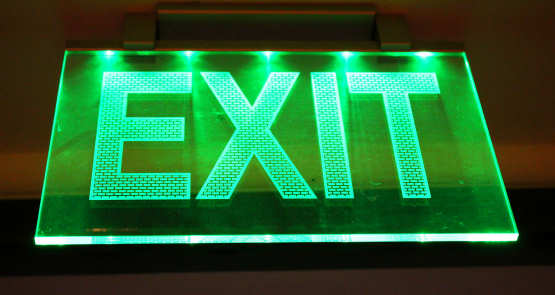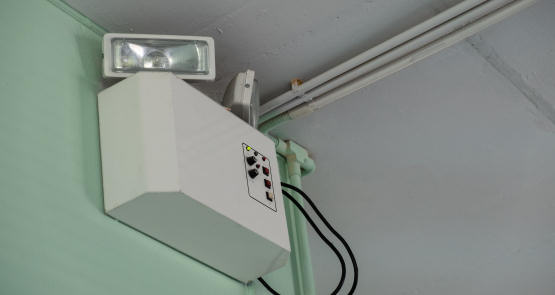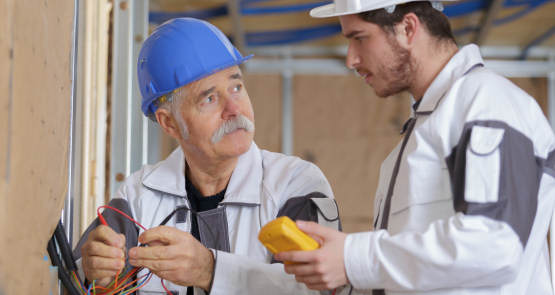When the main power to a building such as, a commercial building being a hotel, schools, colleges, office blocks, hospitals, or an apartment complex such as a block of flats, cuts out due to a power cut or fire situation, the emergency lighting system takes over. If this were not in place there would be total darkness for staff and workers in a commercial building or occupants and tenants in a block of flats or apartment complex. This means in the case of a fire the route out to the exit points would be very difficult to find resulting in potential loss of life. This is why emergency lighting is so important, it activates automatically when the main power is cut and illuminates corridors and stairways sufficiently enough to guide you to the nearest exits points out of the building. All new builds for these types of buildings and complexes have emergency lighting installed in their construction programme designed by the architect responsible for the build and complying with the local authorities rules, current Building Regulations and British Standards guidelines BS 5266-1: 2011
British Standards guidelines (BS 5266-1: 2011) will recommend the design and duration of a particular emergency lighting system for a building but its prudent to remember that the recommendations are for minimum safe standards required, so in some cases it may be necessary to consider a system designed to a higher standard.
Emergency escape lighting & emergency lighting
Emergency lighting is standby lighting, which illuminates fully automatically when normal lighting fails, its function is to allow everyday work or activities to carry on as normal. Escape lighting activates with the emergency lighting and can show you the exits routes out of the building in the event of a fire. This form of lighting is required for fire safety and included in The Regulatory Reform Order 2005 for Fire Safety. This lighting can be categorised as:


Open area lighting / escape route lighting
This is known as emergency exit lighting or in some countries they call it anti panic lighting. Its function is to illuminate the quickest route safety to the nearest fire exits so occupants and vacate the building in a safe and non-panic manner.
High risk task area lighting
This can also be known as bulkhead emergency lighting. Its function is to provide suitable illumination for the safe evacuation of persons who are involved in a hazardous procedure or circumstance and making it possible to perform the correct safe procedures to shut down certain machinery safely so as to safeguard other people and operators who are in the building.
Survey & design
If you are thinking of having an emergency escape lighting installation its prudent to have an initial survey so your system can be tailor designed to suit your requirements. A risk assessment will be undertaken and a plan drawn up showing all areas of high and low risk marking where lighting is necessary. A number of queries need to be addressed such as:
Self contained single point power supply
ADVANTAGES:
DISADVANTAGES:
The choice between having a self-contained power supply to a battery operated one usually comes down to cost. It you require durability with low maintenance as a must have then the more expensive central battery option could very well be more practical especially on a large system. Installation costs and the amount of luminaires are the primary considerations to take into account especially if money is tight and you only have a small project. So in these cases the self-contained power supply systems are a better choice.
Central battery source
ADVANTAGES:
DISADVANTAGES:
Mode of operations
The main factor to consider when having an emergency lighting system installed is whether to choose:
Non-maintained system
Luminaires that activate when normal lighting fails usually in a working environment such as offices so work can carry on with artificial lighting while the building is occupied and it is safe to do so.
Maintained system
Emergency lighting luminaires that are constantly active will require maintenance. Maintained emergency lighting systems and maintained fire exit signs are usually found in public places where there can be a large gathering of people such as cinemas, theatres, halls and clubs complying with BS 5266. The lighting is dimmed whilst the building is occupied with the emergency escape lighting protecting against a total black out and the fire exits signs being well lit providing people with a clear path to guide them to the nearest escape route in the event of an evacuation when main power has not failed.
Combined emergency luminaires
If a luminaire has more than one lamp one of which is powered by the emergency lighting supply and the other by the normal main power is known as a combined luminaire. These can be non-maintained or maintained.
Self contained emergency luminaires
This is either a non-maintained or maintained luminaire providing emergency lighting and the emergency power for a satellite luminaire.
Satellite emergency luminaires
This is a luminaire designed for non-maintained or maintained functions supplied by power from a self-contained emergency luminaire.
Facilities:


Duration time
This is determined by calculating the time taken to evacuate the building and the size of the building in question. Another factor to consider is whether the building is evacuated as soon as normal power and lighting fails or the building is immediately occupied the second the power is reconnected.
Emergency escape lighting minimum duration time is one hour with emergency escape lighting set at three hours for a building not vacated immediately such as sleeping accommodations and building that are immediately occupied the second the power is reconnected and not waiting for the recharging of batteries.
For buildings that are vacated immediately as soon as normal power and lighting fails and not reoccupied until the batteries have been fully charged one-hour time duration is applied.
For further information see BS 5266 for the recommended duration times applicable to systems in a variety of buildings.
Installation Positions For Emergency Lighting & Signs
Once you have chosen your system the next consideration is the positioning of the signs and lighting units in your building. Once you have done this you are then able to decipher the correct equipment to use. All emergency signs and lighting units need to be located in a position clearly visible showing the route to the nearest exits points out of the building. If a particular exit route is not recognisable its more effective to use a sign in place of a lighting unit.
Considerations should be made for:
If you consider these areas carefully ensuring they are all covered the completed installation will pass all necessary requirements. You do not have to provide individual lighting for each of these items as long as there is sufficient light for them to be clearly visible so they can be used.
How much light do I use?
BS 5266 recommendations for lighting along escape routes are not less than 1 LUX and 0.5 LUX for anti panic areas with a 0.5 metre perimeter surrounding the route. When you have a 2-metre or more wide escape route you must ensure that 50% is lit with a minimum of 1 LUX. The amount of light will vary and is dependant on what its being used for. It also needs to be correlated with the nature of the building, its occupants and what the building is used for such as hotels for overnight accommodation, hospitals, care homes, crowed venues such as night clubs, bars and supermarkets etc. For more information please see BS 5266 – 1: 2011
Maintenance
Everything needs maintenance to ensure it keeps works at peak performance and emergency lighting is not different. You should always book in periodic testing and inspecting to keep the system in tiptop condition. Spare lamps need to be on site and ready available for use in the case of one failing.
Testing, inspecting & servicing
When testing an emergency lighting system you need to simulate a power cut happening to the normal lighting supply. If this is not done alternately you can perform this to each luminaries separately in turn. This action will trigger the emergency lighting system to kick in using the battery supply. This form of test can be initiated automatically or as a manual test.
Testing manually
When the system is initially installed if you have a switch fitted to isolate all lighting circuits, individual luminaires and individual circuits. When testing manually and after mains power failure has been simulated, especially in a large complex, an inspection of the complete building needs to be carried out by walking through every corridor to check that every emergency light has activated. Once main power has been restored unfortunately you will need to walk the complete building again to verify that the emergency lighting are recharging. You will only need to walk the entire building once if the emergency luminaires are switched separately but by having this system can make the internal decoration unsightly by having tamper proof test switches on the wall. Once all testing is complete it is prudent to enter the results into a logbook for fire safety.
Testing automatically
Manual testing can be expensive and there is considerable disruption to your normal working day. So by having a self-testing emergency lighting system installed is the way forward. There are a number of systems with a variety of formats to choose from. All annual and monthly test result must still be logged in the logbook for fire safety.
Discharge testing
This form of testing has to be performed outside the normal working day when the building is empty. In premises that are constantly occupied, such as hospitals, the test needs to be balanced so every other luminaires are tested.
It is vital to maintain servicing regularly by appointing a competent person to carry out the system servicing. This chosen person is to have all necessary authority to safeguard any necessary works are carried out in order to maintain the smooth running of the system.
After a test or during the recharge period there is always a possibility of a power cut and losing the normal lighting supply for real. So wherever possible a full duration test should be carried out before a time of low risk to let the batteries fully recharge.
Everyday Emergency Lighting Inspections For Central Back Up Systems Only
Visual inspection only required of the central power supply to ensure that the system is functioning correctly. There is no operational test requirement. However, this does not apply to self contained battery back up emergency lighting units which is standard emergency lighting.
Monthly testing
It is mandatory to test emergency lighting on a monthly basis. The test is functional and must comply with BS 5266-8:2004 / BS EN 50172:2004. All signs and luminaires should be checked to safeguard they are clean, function correctly and are not damaged. All monthly test result must be logged in the logbook for fire safety. Annual Testing
It is mandatory that a 3-hour test for the full duration time of the emergency lights be carried out after which all emergency lighting must still be active and working. All annual test result must be logged in the logbook for fire safety. Any faults or failures recorded must be rectified as soon as possible.
Emergency LED lighting
When designing a emergency lighting plan for a building it’s always a good idea to remember that lighting lamps are changing and a lot of our lighting is now in LED format. Having a LED system has a number of advantages such as:
Here at Acorn Electrical & Mechanical can advise you of the most suitable approved emergency lighting system on the market being standard or LED.
Why Choose Acorn Electrical & Mechanical
We are based in Plymouth Devon so we cover the complete South West. We have a team of skilled electricians who are passionate about their work and have been doing it for over 15 years.
Our team offers:
Please feel free to call us for help or advice.
If you are interested in booking a survey for any of our services or just a safety check, please contact Acorn Electrical & Mechanical (AEM) and a member of our team will be happy to help or advise you. CALL now on 01752 201077 or 07779 777965

